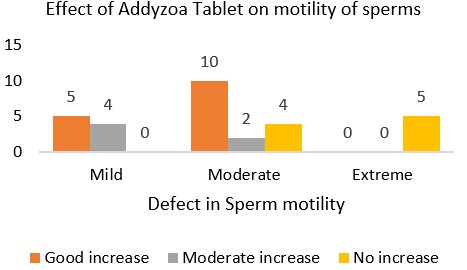Clinical Assessment of Efficacy and Safety of Addyzoa Tablet in Male Infertile Patients with Oligospermia and Asthenospermia
DOI:
https://doi.org/10.21760/jaims.9.6.3Keywords:
Oligospermia, Asthenospermia, Density, Male infertility, M. pruriens, Motility, W. sominifera.Abstract
Infertility is defined as inability of a sexually active couple to conceive after 1 year of regular intercourse without contraception. Male factors account for 20%-50% of cases of infertility. Male infertility is primarily caused by low sperm count (Oligospermia) and reduced sperm motility (asthenospermia), and is an issue of global dimensions. Oligospermia in a clinically healthy man is one of the commonest conditions encountered in an infertility clinic. Medical management of oligospermia lags far behind expectations, and is still in experimental stage. The global deterioration of male reproductive health is of a major concern. The modern therapeutic approaches to combat male infertility are expensive, less accessible, have long term treatment tenure and possess various side effects. Whereas, the herbal therapies, are better positioned to offer more holistic approaches to improve male reproductive health. The present study was carried out to evaluate the efficacy and safety of Addyzoa Tablet manufactured by Charak Pharma Pvt. Ltd., an herbal formula comprising of extracts of Withania somnifera, Tribulus terrestris, Mucuna pruriens, Chlorophytum arundinaceum etc. Aim was to determine whether treatment would improve sperm count and morphology of sperms. The mechanisms involved in the efficacy of these medicinal plants in sperm abnormalities are antioxidant, anti-inflammatory, anti-oedematous and venotonic activity as well as containing precursors for sperm production and increasing blood testosterone level. It was concluded that Addyzoa Tablet improves the density and motility of the sperms and thus is effective in the management of oligospermia and asthenospermia and no adverse effects were reported.
Downloads
References
4th ed. Cambridge: Cambridge University Press; 1999. World Health Organization. WHO Laboratory Manual for the Examination of Human Semen and Semen-Cervical Mucus Interaction; pp. 1–86.
Men's Health – Male Factor Infertility. University of Utah Health Sciences Center. 04 January, 2003. Archived from the Original on 04 July 2007.
Brugh VM, 3rd, Lipshultz LI. Male factor infertility: Evaluation and management. Med Clin North Am. 2004;88:367–85.
Hirsh A. Male subfertility. BMJ. 2003;327:669–72.
Lotti F, Maggi M. Ultrasound of the male genital tract in relation to male reproductive health. Hum Reprod Update. 2015;21:56–83.
Cooper TG, Noonan E, von Eckardstein S, Auger J, Baker HW, Behre HM, et al. World Health Organization reference values for human semen characteristics. Hum Reprod Update. 2010;16:231–45.
Plachot M, Belaisch-Allart J, Mayenga JM, Chouraqui A, Tesquier L, Serkine AM. Outcome of conventional IVF and ICSI on sibling oocytes in mild male factor infertility. Hum Reprod. 2002;17:362–9.
Sabra SM, Al-Harbi MS. An influential relationship of seminal fluid microbial infections and infertility, Taif Region, KSA. World J Med Sci. 2014;10:32–7.
Aitken RJ, Sutton M, Warner P, Richardson DW. Relationship between the movement characteristics of human spermatozoa and their ability to penetrate cervical mucus and zona-free hamster oocytes. J Reprod Fertil. 1985;73:441–9.
Carlsen E, Giwercman A, Keiding N, Skakkebaek NE. Evidence for decreasing quality of semen during past 50 years. BMJ. 1992;305:609–13.
Kaltsas A. Oxidative Stress and Male Infertility: The Protective Role of Antioxidants. Medicina. 2023; 59(10):1769. https://doi.org/10.3390/medicina59101769
Tahvilzadeh M, Hajimahmoodi M, Toliyat T, Karimi M, Rahimi R (2016). An evidence‐based approach to medicinal plants for the treatment of sperm abnormalities in traditional Persian medicine. Andrologia 48(8):860-879.
Gupta A, Mahdi AA, Shukla KK, Ahmad MK, Bansal N, Sankhwar P, Sankhwar SN (2013). Efficacy of Withania somnifera on seminal plasma metabolites of infertile males: a proton NMR study at 800 MHz. Journal of Ethnopharmacology 149(1):208-214.
Ambiye VR, Langade D, Dongre S, Aptikar P, Kulkarni M, Dongre A (2013). Clinical evaluation of the spermatogenic activity of the root extract of Ashwagandha (Withania somnifera) in oligospermic males: a pilot study. Evidence-Based Complementary and Alternative Medicine. Volume 2013, Article ID 571420, 6 pages.
Kamla Kant Shukla, Abbas Ali Mahdi, Vivek Mishra, Singh Rajender, Satya Narain Sankhwar, Devender Patel, Mukul Das. Withania somnifera improves semen quality by combating oxidative stress and cell death and improving essential metal concentrations.,Reproductive BioMedicine Online (2011) 22, 421– 427
Saurabh Chhatre, Tanuja Nesari, Gauresh Somani,1 Divya Kanchan, and Sadhana Sathaye Phytopharmacological overview of Tribulus terrestris Pharmacogn Rev. 2014 Jan-Jun; 8(15): 45–51.
Tribulus terrestris L. extract improves spermatozoa motility and increases the efficiency of acrosome reaction in subjects diagnosed with oligoastheno-teratozoospermia L. Setiawan Airlangga University, Surabaya, Indonesia (1996)
Gauthaman K, Adaikan PG, Prasad RN. Aphrodisiac properties of Tribulus Terrestris extract (Protodioscin) in normal and castrated rats Life Sci. 2002;71:1385–96
Anam Ara, Rahul Vishvkarma, Poonam Mehta, Singh Rajender, "The Profertility and Aphrodisiac Activities of Tribulus terrestris L.: Evidence from Meta-Analyses", Andrologia, vol. 2023, Article ID 7118431, 21 pages, 2023. https://doi.org/10.1155/2023/7118431
Nandkarni KM. Indian materia medica. Bombay: Popular Prakashan, 1986. 153–5.
Misra L, Wagner H. Extraction of bioactive principle from Mucuna pruriens seeds. Indian J Biochem Biophys 2007;44:56–60
Bano F, Singh RK, Singh R, Siddiqui MS, Mahdi AA. Seminal plasma lipid profiles and lipid peroxide in infertile men. J Endocrinol Reprod 1999;3:20–8.
Iwasaki A, Gagnon C. Formation of reactive oxygen species in spermatozoa of infertile patients. Fertil Steril 1992;57:409–16.
Ames BN, Shigenaga MK, Hagen TM. Oxidants, antioxidants and the degenerative diseases of aging. Proc Natl Acad Sci U S A 1993;90:7915–22
https://echarak.in/echarak/templates/Chlorophytum%20arundinaceum%20Baker.pdf
Phurailatpam, & Geetha, K.A. & Gajbhiye, N. & Saravanan, Raju. (2009). Comparative study of Chlorophytum borivilianum and C. arundinaceum – two safed musli species used as vital tonic in Indian Systems of Medicine. Phytomorphology: An International Journal of Plant Morphology. 59. 77-81.
Chetna Gangwar, Ashok Kumar, Anil Kumar Mishra, S D Kharche, et al, Asparagus racemosus improves seminal antioxidant status and sperm characteristics in buck semen at refrigeration temperature., Indian Journal of Animal Sciences 93(11): 1072–1076, November 2023.
Javeed Ahmed Wani, Rajeshwara N. Achur, R. K. Nema, Phytochemical Screening and Aphrodisiac Activity of Asparagus racemosus., IJPSDR April-June, 2011, Vol 3, Issue 2 (112-115).
Mradu Gupta, Saikat Chowdhury and Sukumar Manna, In vitro Impact Assessment of Aqueous Extract of Sida cordifolia Linn. Upon Rat Spermatozoa Parameters., Asian Journal of Medicine and Health 1(2): 1-10, 2016.















